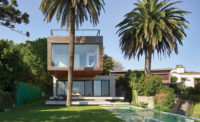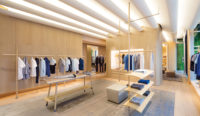Sometimes architects' enthusiasm for modernist designs in residential commissions ends up with predictable results. But the same-old, same-old syndrome does not apply in the case of the compact 1,700-square-foot, one-bedroom cottage for the Las Musas vacation retreat in José Ignacio, near Punte del Este, Uruguay. It demonstrates convincingly how well-crafted details, rendered in native woods with a concrete structure, and elegant proportions can reinvigorate the language of 20th-century masters. Mathias Klotz, a Chilean architect with an office in Santiago, and longtime friend Carolina Pedroni, an architect based in Punta del Este, worked with an Argentine client, Sandra Perelmuter, to create a private enclave not far from the point where the Rio de la Plata flows into the Atlantic Ocean. Klotz and Pedroni’s master plan for the 12-acre property calls for nine houses of one and two stories and a small, 12-room hotel to be arranged around common spaces—a restaurant, wine cellar, yoga pavilion, and swimming pool.
The architects designed the first completed villa so that it appears to levitate lightly above the compound’s lawn, to which it is connected by open-riser steps—bringing to mind Mies van der Rohe’s Farnsworth House of 1951 in Plano, Illinois. The cottage’s concrete roof projects over a gallery that wraps partly around the house and can be closed in by wood folding screens. When pulled back into vertical clusters, the screens create pier-like forms on which the heavy roof almost seems to rest. This pseudo-structural articulation evokes the lightness of touch that Louis Kahn displayed in his Trenton Community Center bathhouse (1955), where pyramidal roofs appear to barely sit on concrete-block piers.
Klotz and Pedroni chose a local reddish wood (Lapacho) for these shutters, which fold on the south side and partly on the east, then turn into flat scrims along the rest of the exterior walls. When closed, this “veil,” as Klotz calls it, gives the sheltered porches privacy, and the house can become a discreetly flat wood chest—the extreme opposite of Farnsworth’s transparency. When the screens are pulled back, the entire volume turns into one large covered porch by virtue of expansive window walls that slide open between the living/dining room and bedroom. (The warm-temperate climate promotes outdoor living, with highs of 60 degrees in July, 80 in January.)
Inside, the architects used Brazilian Louro wood for wall paneling and left the concrete roof deck exposed for the ceiling, while covering the floor in travertine. The richly tactile surfaces provide a quiet setting for the minimal furnishings chosen by interior designer Mauro Bernardini.
Spaces flow from the dining room, kitchen, and living room to the porch without hallways; the only circulation element is a stair on the exterior west face. It ascends to the roof terrace, where guests can sunbathe and look at the surrounding landscape, a nearby lagoon, and, in the distance, the sea. Photovoltaic panels installed on one portion of the roof help generate energy for the air-conditioning.
The architects strove for “the luxury of simplicity,” says Klotz, who searched for “the essential” instead of relying on “useless spaces and complex programs.” In their interpretation of modernist strategies, Klotz and Pedroni have created a comfortable haven that pays fitting homage to the high points of this familiar legacy.











Post a comment to this article
Report Abusive Comment